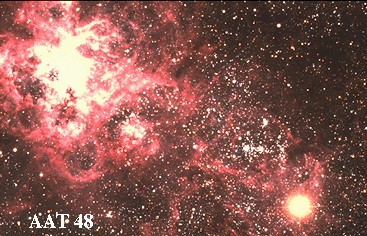Credit & Copyright: Anglo-Australian Telescope
Board
Explanation:
In this close-up of the Large Magellanic Cloud,
the spidery looking nebula on the left is fittingly known as
as the Tarantula nebula. It is an
emission nebula
surrounding a cluster of hot, young stars
called the 30 Doradus super cluster. This
cluster may contain the most massive stars known (about 50 times
the mass of the Sun). Such massive stars put out
more than 100 times as much energy as our Sun.
The bright "star" (lower right) is actually
Supernova 1987a
and is a harbinger of things to come for the stars
within the Tarantula. Massive stars
burn their nuclear fuel at drastically enhanced rates to support
their high energy output. As a result their lives
last only a few million years compared to the Sun's few billions of years.
They end in a spectacular death explosion, a
supernova,
like the star which exploded in 1987 as seen above.
Supernovae may leave behind imploded stellar cores which
form neutron stars or
black holes.
Authors & editors:
Robert Nemiroff
(MTU) &
Jerry Bonnell
(USRA)
NASA Web Site Statements, Warnings,
and Disclaimers
NASA Official: Jay Norris.
Specific
rights apply.
A service of:
LHEA at
NASA /
GSFC
& Michigan Tech. U.
Based on Astronomy Picture
Of the Day
